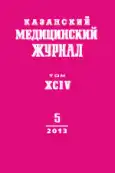Prognostic factors for anti-cancer therapy efficiency
- Authors: Erlykina EI1, Kopytova TV1, Alyasova AV1, Terentiev IG1, Gorshkova TN2, Pimenov VG3, Evdokimov IL3, Obukhova LM1
-
Affiliations:
- Nizhny Novgorod State Medical Academy, Nizhny Novgorod, Russia
- Volga District Medical Centre, Nizhny Novgorod, Russia
- G.G. Devyatykh Institute of Chemistry of High-Purity Substances, Nizhny Novgorod, Russia
- Issue: Vol 94, No 5 (2013)
- Pages: 681-685
- Section: Actual problems of biochemistry and laboratory diagnostics
- URL: https://journals.rcsi.science/kazanmedj/article/view/1919
- DOI: https://doi.org/10.17816/KMJ1919
- ID: 1919
Cite item
Full Text
Abstract
Full Text
##article.viewOnOriginalSite##About the authors
E I Erlykina
Nizhny Novgorod State Medical Academy, Nizhny Novgorod, Russia
T V Kopytova
Nizhny Novgorod State Medical Academy, Nizhny Novgorod, Russia
A V Alyasova
Nizhny Novgorod State Medical Academy, Nizhny Novgorod, Russia
I G Terentiev
Nizhny Novgorod State Medical Academy, Nizhny Novgorod, Russia
T N Gorshkova
Volga District Medical Centre, Nizhny Novgorod, Russia
V G Pimenov
G.G. Devyatykh Institute of Chemistry of High-Purity Substances, Nizhny Novgorod, Russia
I L Evdokimov
G.G. Devyatykh Institute of Chemistry of High-Purity Substances, Nizhny Novgorod, Russia
L M Obukhova
Nizhny Novgorod State Medical Academy, Nizhny Novgorod, Russia
Email: ObuhovaLM@yandex.ru
References
- Блохин Ю.Д. Фенотип множественной лекарственной устойчивости опухолевых клеток, обусловленный нарушением программы клеточной гибели // Вестн. РАМН. - 2004. - №12. - С. 16-20.
- Дубинина Е.Е. Продукты метаболизма кислорода в функциональной активности клеток. Жизнь и смерть, созидание и разрушение // СПб.: Медицинская пресса, 2006. - 400 с.
- Дубинина Е.И., Бурмистров С.О., Ходов Д.А., Поротов И.Г. Окислительная модификация белков сыворотки крови человека, метод её определения // Вопр. мед. хим. - 1995. - Т. 41, №1. - С. 24-25.
- Копытова Т.В., Добротина Н.А., Химкина Л.Н., Ларина Т.Н. Некоторые подходы к лабораторной диагностике эндоинтоксикации при хронических дерматозах // Клин. лаб. диагн. - 2000. - №1. - С. 18-20.
- Малахова М.Я. Эндогенная интоксикация как отражение компенсаторной перестройки обменных процессов в организме // Эффер. терап. - 2000. - Т. 6, №4. - С. 3-14.
- Орлов Д.С., Носарева О.Л., Коновалова Е.В. и др. Содержание гидроксильного радикала и фракций глутатиона в опухолевых клетках линии Jurkat и лимфоцитах крови // Соврем. наукоёмкие технол. - 2012. - №7. - С. 58-59.
- Руководство по химиотерапии опухолевых заболеваний / Под ред. Н.И. Переводчиковой. 2-е изд., доп. - M.: Практическая медицина, 2005. - 365 с.
- Apetoh L., Ghiringhelli F., Tesniere A. et al. Toll-like receptor 4-dependent contribution of the immune system to anticancer chemotherapy and radiotherapy // Nat. Med. - 2007. - Vol. 13,N 9. - P. 1050-1059.
- Aschele C., Lonardi S., Monfardini S. Thymidylate synthase expression as a predictor of clinical response to fluoropyrimidine-based chemotherapy in advanced colorectal cancer // Cancer Treat Rev. - 2002. - Vol. 28, N 1. - Р. 27-47.
- Joshi M.B., Shirota Y., Danenberg K.D. et al. High gene expression of TS1, GSTP1, and ERCC1 are risk factors for survival in patients treated with trimodality therapy for esophageal cancer // Clin. Cancer Res. - 2005. - Vol. 11, N 6. - Р. 2215-2221.
- Lake R.A., Robinson B.W.S. Immunotherapy and chemotherapy- a practical partnership // Nature Reviews. Cancer. - 2005. - Vol. 5. - P. 397-405.
- Libra M., Navolanic P.M., Talamini R. et al. Thymidylate synthetase mRNA levels are increased in liver metastases of colorectal cancer patients resistant to fluoropyrimidine-based chemotherapy // BMC Cancer. - 2004. - Vol. 4,N 1. - Р. 11-17.
- Mir M.M., Dar N.A., Malik M.A. et al. Studies on association between Copper excess, Zinc deficiency and P53 mutations in esophageal squamous cell carcinoma from Kashmir valley, India - a high risk area // Intern. J. of Health Sciences. - Vol. 1,N 1. - 2007. - Р. 35-41.
- Obeid M., Tesniere A., Ghiringhelli F. et al. Calreticulin exposure dictates the immunogenicity of cancer cell death. - Nat. Med. - 2007. - Vol. 13,N 10. - Р. 54-61.
- Richardson D.R., Kalinowski D.S., Lau S. et al. Canсer cell iron metabolism and the development of potent iron chelators as anti-tumor agents // Biochim. Biophys. Acta. - 2009. - Vol. 1790,N 7. - P. 702-717.
Supplementary files






